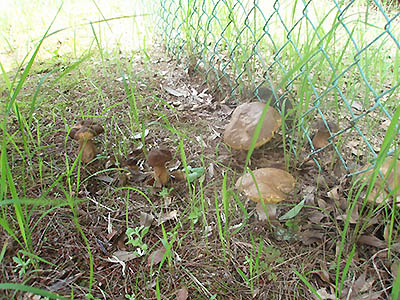Home > Research > Research Results > Research Results 2020 > The growth of oak seedlings was enhanced by using spore fluid from Boletus reticulatus
Update:November 6, 2020
Main content starts here.
The growth of oak seedlings was enhanced by using spore fluid from Boletus reticulatus
| Article title |
Growth and nutrient acclimation of evergreen oak seedlings infected with Boletus reticulatus in infertile colluvial soil in warm temperate monsoon Asia: evaluation of early growth |
|---|---|
| Author (affiliation) |
Masazumi Kayama (a) (a) Department of Plant Ecology, FFPRI, Tsukuba, Ibaraki, Japan. |
| Publication Journal |
Forests, 11(8), 870, August 2020 DOI:10.3390/f11080870( External link ) |
| Content introduction |
Evergreen oaks, which are the main tree species of laurel forests, have formed a symbiotic relationship with mushroom species called ectomycorrhizal fungi. The spores of these ectomycorrhizal fungi ("seeds" in the plant world) coexist with the roots of the plants, where they help the plants to absorb water and nutrients such as phosphorus and nitrogen. Therefore, it is known that these fungi will help to promote the growth of seedlings if the seedlings are inoculated with them before planting. However, inoculation has required expensive equipment for the separation and culture of mycorrhizal fungi, so it has not been possible to perform inoculations in a simple manner. In the present study, spores of the ectomycorrhizal fungus Boletus reticulatus, which flourishes in laurel forests, were used to develop a simple method for inoculating oak species such as Quercus acuta, Quercus glauca, and Quercus salicina, and to clarify the effects that this had on seedling growth. First, oak seeds were planted in pots filled with sterilized soil and grown into seedlings. Next, fruiting bodies of B. reticulatus (pileus parts) were cut into pieces of roughly 3cm square and wrapped in gauze and squeezed in sterilized water. The spores that were released into the water were collected to create spore fluid. This spore fluid was poured into the soil that had been filled into the pots to perform a simple inoculation. As a result, it was confirmed that after 6 months, the growth of inoculated seedlings was better than that of non-inoculated seedlings. This research will contribute to the enhancement of silvicultural techniques using ectomycorrhizal fungi.
Photo2: Seedlings of Quercus acuta 6 months after inoculation with Boletus reticulatus. |
Copyright © Forest Research and Management Organization. All rights reserved.


